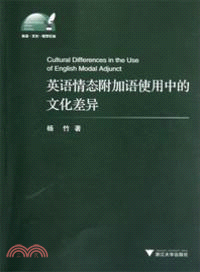商品簡介
《英語情態附加語使用中的文化差異》以比較中美文化背景為例,以分別具有兩種文化背景的作者在英文媒體發表的個人評論文章為語料來源,相應建立了規模相當的兩組有控制的書面語料,並採用嚴格的分析方法,比較了兩組語料問使用情態附加語的差異。結果顯示出以下主要的差異:美方語料中使用的情態附加語在頻率上顯著高於中方語料,並且美方語料中使用的情態附加語的類型也多於中方語料;這些差異尤其體現在其中某些語義類別的情態附加語的使用上。
名人/編輯推薦
目次
List of Tables
List of Abbreviations
Chapter 1 Introduction
1.1 Scope of the Study
1.2 Modal Adjunct in a Cross-Cultural Perspective
1.3 Rationale and Objective
1.4 Overview of Methodology
1.5 Book Organization
Chapter 2 Literature Review
2.1 Modal Adjunct
2.1.1 Meaning
2.1.2 Structure
2.1.3 Function in information structure
2.2 Sociolinguistic Perspectives to Modality
2.2.1 Sociopragmatic perspective
2.2.2 Variationist perspective
2.2.3 Cross cultural perspective
2.3 Cross-Cultural Differences in English Language Use
2.4 American-Chinese Cultural Differences in Language Use
2.5 Summary
Chapter 3 Methodology
3.1 Research Questions
3.2 Operational Definitions
3.3 Theoretical Framework
3.3.1 The framework
3.3.1.1 Face systems
3.3.1.2 Solidarity face system
3.3.1.3 Involvement
3.3.1.4 Note on application
3.3.2 Advantage of the framework
3.3.2.1 Theoretical foundation
3.3.2.2 Analytic validity
3.4 Data Collection and Analysis
3.4.1 Nature of the data
3.4.2 Data collection
3.4.3 Data analysis
3.4.3.1 Structural analysis
3.4.3.2 Semantic considerations
Chapter 4 Results
4.1 General Results
4.1.1 Overall distribution of modal adjunct
4.1.2 General difference
4.2 Differences Along Semantic Categorization of Modal Adjl
4.2.1 Broad sets of modal adjunct
4.2.2 Subsets of modal adjunct
4.2.3 Interim summary
4.3 General Interpretation
4.3.1 English proficiency
4.3.2 Sociopolitical context
4.3.3 Cultural background
Chapter 5 Interpretation and Discussion
5.1 Functional Analysis of Modal Adjunct
5.1.1 Information function
5.1.2 Involvement function
5.2 Functional Interpretation of the Differences
5.2.1 The use of modal adjunct of extent
5.2.2 The use of modal adjunct of focalization
5.2.3 The use of modal adjunct of certainty
5.2.4 The use of modal adjunct of comment
5.2.5 The use of modal adjunct of exclamation
5.2.6 The use of the other subsets of modal adjunct
5.2.7 Interim summary
5.3 Discussion of the Difference in Solidarity Face System
5.4 Theoretical Discussion
Chapter 6 Conclusion
6.1 Summary of the Study
6.2 Implications
6.3 Limitations and Suggestions for Future Research
References
Appendix A Sources of Linguistic Data
Appendix B Sample Texts
Appendix C List of Identified ModalAdjuncts
Index
書摘/試閱
Meanwhile, written discourse has some advantages over spoken discourse as far as the present study is concerned. The written medium matters to the study of modal expressions in discourse context. Modality semantically belongs to subjectivity in the large. Subjectivity is prevalent in language, but it is possible for it not to be manifest in utterance. It is quite possible for subjectivity to be expressed prosodically or paralinguistically in speech without being encoded in the grammatical or lexical structure of the language-system (Lyons, 1995). Prosodic and paralinguistic exponents of subjectivity may possibly outweigh other types of exponent (e.g. lexical exponent) of subjectivity through the spoken medium. According to Biber (2006), it is found that modality (stance) is overtly marked in spoken texts much more than in written texts. Consequently, it is reasonable to restrict our data to written product.Written discourse, as well as spoken discourse, provides the interactional features of language that can be studied with reference to the categories previously defined in the framework of analysis (e.g. involvement and solidarity face system).
Third, the type of content (personal commentary on certain subject matters) and the manner of production (published in the media) specify the discourse goal. The goal of a discourse refers to the communicative purpose or function, which is usually composed of an overriding function (superfunction) and some sub-functions (hyperfunctions) (a view supported by Cook, 1992). It is similar to intentionality, one of the seven standards of textuality (i.e., what makes up a text) suggested by Beaugrande and Dressier (1986). As Dooley and Levinson (2000) explain, "Each text type has a particular social and cultural purpose, around which clusters a characteristic combination of linguistic or textual properties." Discourse goal is perhaps the primary defining factor for a discourse type, and it is usually the defining factor for a genre. Speaker's communicative intent can shape the discourse characteristics, and it has important impact on the comparison of discourse as regards certain linguistic features (Bartsch, 1997). As Hunston (1993) argues, "the ideology (the discourse goal or global speech act) within which a text is written constrains choices in discourse organization, grammar and lexis" (annotation added).
主題書展
更多主題書展
更多書展本週66折
您曾經瀏覽過的商品
購物須知
大陸出版品因裝訂品質及貨運條件與台灣出版品落差甚大,除封面破損、內頁脫落等較嚴重的狀態,其餘商品將正常出貨。
特別提醒:部分書籍附贈之內容(如音頻mp3或影片dvd等)已無實體光碟提供,需以QR CODE 連結至當地網站註冊“並通過驗證程序”,方可下載使用。
無現貨庫存之簡體書,將向海外調貨:
海外有庫存之書籍,等候約45個工作天;
海外無庫存之書籍,平均作業時間約60個工作天,然不保證確定可調到貨,尚請見諒。
為了保護您的權益,「三民網路書店」提供會員七日商品鑑賞期(收到商品為起始日)。
若要辦理退貨,請在商品鑑賞期內寄回,且商品必須是全新狀態與完整包裝(商品、附件、發票、隨貨贈品等)否則恕不接受退貨。

























